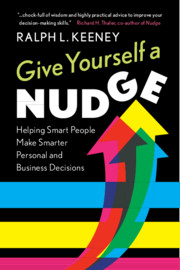Book contents
- Reviews
- Give Yourself a Nudge
- Give Yourself a Nudge
- Copyright page
- Dedication
- Contents
- Preface
- Acknowledgments
- 1 Nudge Yourself to Make Better Decisions
- 2 Your Decisions and Your Life
- 3 Making Value-Focused Decisions
- 4 Defining Your Decision
- 5 Identifying Your Values
- 6 Creating Alternatives
- 7 Identifying Decision Opportunities
- 8 Obtaining Authorization to Select Alternatives Controlled by Others
- 9 Becoming a Value-Focused Decision-Maker
- 10 Enhancing the Quality of Your Life
- 11 Useful Perspectives on Decision-Making
- Appendix Evaluating Alternatives and Making a Decision
- Notes
- Index
3 - Making Value-Focused Decisions
Published online by Cambridge University Press: 17 April 2020
- Reviews
- Give Yourself a Nudge
- Give Yourself a Nudge
- Copyright page
- Dedication
- Contents
- Preface
- Acknowledgments
- 1 Nudge Yourself to Make Better Decisions
- 2 Your Decisions and Your Life
- 3 Making Value-Focused Decisions
- 4 Defining Your Decision
- 5 Identifying Your Values
- 6 Creating Alternatives
- 7 Identifying Decision Opportunities
- 8 Obtaining Authorization to Select Alternatives Controlled by Others
- 9 Becoming a Value-Focused Decision-Maker
- 10 Enhancing the Quality of Your Life
- 11 Useful Perspectives on Decision-Making
- Appendix Evaluating Alternatives and Making a Decision
- Notes
- Index
Summary
A good decision-making process includes a series of steps based on logic and common sense that helps you understand and address the complexities of your decision. The intended product of this process is to provide insight to make better-informed, and therefore better, decisions. A value-focused decision-making process to make high-quality decisions consists of six components. The three front-end components state the decision problem or decision opportunity that you face, identify your values for that decision to clarify what you want to achieve, and create alternatives that contribute to achieving your values. A high-quality front end has a much greater influence on making a better decision than the back end, which describes the consequences of the competing alternatives and evaluates the desirability of those alternatives. This book concentrates on the three front-end components. Several procedures for identifying values and creating alternatives are described in detail and illustrated in several case studies and examples. Your objectives and the set of alternatives for your decision statement provide the basis for a precise description of your decision, referred to as a decision frame.
Keywords
- Type
- Chapter
- Information
- Give Yourself a NudgeHelping Smart People Make Smarter Personal and Business Decisions, pp. 23 - 35Publisher: Cambridge University PressPrint publication year: 2020

